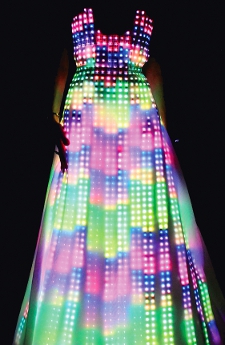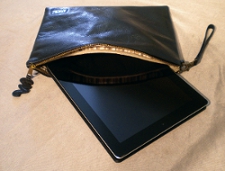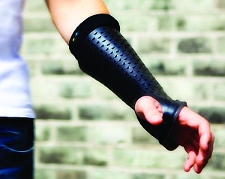Fashion, Form & Function

From Lady Gaga’s glowing, LED-encrusted gown to lightweight body armor and high-tech sports apparel, engineered fabrics are turning up well beyond the fashion world. ASEE’s Prism magazine highlights some innovative examples in its summer 2012 issue:
Clothes Horse
High-performance garb is de rigeur for athletes. Now, it’s racehorses’ turn. This colorful suit, designed by Matthew Spice of Sydney, Australia, harnesses durable, warp-knit wicking sportswear fabric and a “graduated compression technology” to enhance circulation and help horses rebound from exertion. Spice’s biggest challenge? Maintaining consistent compression around the top of the legs and through the chest. Also, “horses are difficult to clothe as you can’t bend their legs and step them into a garment like this.” Solution: Five YKK high-performance sports zippers. Watch Australia’s equine Olympians turn heads in London.
 Light Fantastic
Light Fantastic
Rihanna, Katy Perry, and Lady Gaga each belt out chart-topping singles in a costume tailor-made for a techno beat and larger-than-life image: an LED dress, among the latest in an unbroken thread of textile innovations since the Industrial Revolution. This version from CuteCircuit turns the wearer into moving art, aglow with Svarovski crystals and 1,500 hand-sewn, wirelessly-controlled LED lights powered by rechargeable Lipo batteries. Wearable technology reaches beyond couture to lightweight military armor and applications in sports, cybersecurity, and medicine. Sensor-studded e-textiles pioneered by chemical engineer Danilo De Rossi of Italy’s University of Pisa, for instance, can help recovering stroke patients. Whether you’re an athlete straining for victory or a rocker plugging in for the Grammys, high-tech fibers show that function can also be fashionable.
Counterspy Wear
 Is your cellphone spilling secrets? Even switched off, most mobile devices emit data, beaming their location to service providers. MIAmobi’s “SilentPocket” cases have a nanosilver lining that blocks all incoming and outbound electromagnetic transmissions, including RFID signals used by hackers and identity thieves to steal information. Research at the nexus of textiles and nanotechnology is yielding a host of new materials, like self-decontaminating fabric, with commercial, environmental, and defense potential. Cornell’s Juan Hinestroza, for instance, is finding new methods of applying nanoscale metal particles to fabrics through electrostatic assembly.
Is your cellphone spilling secrets? Even switched off, most mobile devices emit data, beaming their location to service providers. MIAmobi’s “SilentPocket” cases have a nanosilver lining that blocks all incoming and outbound electromagnetic transmissions, including RFID signals used by hackers and identity thieves to steal information. Research at the nexus of textiles and nanotechnology is yielding a host of new materials, like self-decontaminating fabric, with commercial, environmental, and defense potential. Cornell’s Juan Hinestroza, for instance, is finding new methods of applying nanoscale metal particles to fabrics through electrostatic assembly.
 Heal Thyself
Heal Thyself
Brazilian designer Pedro Nakazato Andrade tries to incorporate a “deep understanding of people” into products and services. Applying social media, he believes, can speed the mending of fractures. Bones, a concept cast that he developed at the Copenhagen Institute of Interaction Design, has embedded electromyographic sensors that capture muscle activity around a break and report the data to a website, where patients can track their recovery, view others’ progress, and find appropriate exercises. As Andrade told Fast Company last summer: “Sharing this information is a way to encourage new users to engage with their recovery process from the beginning of their treatment.”
Stride by Stride
 Practice makes perfect, but elite athletes need more than training to boost performance. Enter the next generation of athletic wear, which can record the body’s movements in fine detail, helping athletes and coaches better understand what makes a great performance. Equipped with electronic sensors and a three-axis accelerometer, this NFL-tested Under Armour E39 biometric shirt monitors breathing and heart rate while measuring the swiftness of a runner’s left and right strides independently. Four students at Northeastern University take the concept even further with Squid, a shirt that tracks muscle activity and counts your reps as it monitors your heart. Four EMG sensors (or “tentacles”) attached to the shirt record muscle movements and send the data directly to a smartphone app and internet portal, keeping users up to date on all their workout habits.
Practice makes perfect, but elite athletes need more than training to boost performance. Enter the next generation of athletic wear, which can record the body’s movements in fine detail, helping athletes and coaches better understand what makes a great performance. Equipped with electronic sensors and a three-axis accelerometer, this NFL-tested Under Armour E39 biometric shirt monitors breathing and heart rate while measuring the swiftness of a runner’s left and right strides independently. Four students at Northeastern University take the concept even further with Squid, a shirt that tracks muscle activity and counts your reps as it monitors your heart. Four EMG sensors (or “tentacles”) attached to the shirt record muscle movements and send the data directly to a smartphone app and internet portal, keeping users up to date on all their workout habits.
Flashy fabric is hot. But dyeing textiles consumes an average of 20 gallons of water per pound of material. A spinoff of the Netherlands’ FeyeCon Group, which began as a Delft University of Technology startup, has developed a completely water-free process that uses carbon dioxide to dye polyester, lowering operational costs and waste. Seeing the technology’s “potential to revolutionize textile manufacturing,” Nike’s Sustainable Business and Innovation Lab recently partnered with the spinoff, DyeCoo Textile Systems, to manufacture footwear and research ways to apply the process to other natural and synthetic fibers.
Filed under: Special Features
Tags: athletics, biometric shirt, Bones, concept cast, CuteCircuit, Cybersecurity, dye, equestrian, fabric, fashion, Hidez, high-performance apparel, LED, Materials Engineering, MIAmobi, nanosilver, Nanotechnology, Nike, Olympics, Pedro Nakazato Andrade, racehorse, Sports, textile manufacturing, textiles, Under Armour








